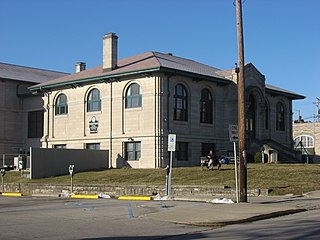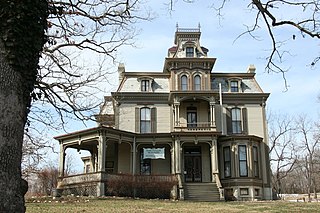
Meramec State Park is a public recreation area located near Sullivan, Missouri, about 60 miles from St. Louis, along the Meramec River. The park has diverse ecosystems such as hardwood forests and glades. There are over 40 caves located throughout the park, the geology of which is a mixture of limestone and dolomite. The most famous is Fisher Cave, located near the campgrounds. The park borders the Meramec Conservation Area.

The Jesse James Home Museum is the house in St. Joseph, Missouri where outlaw Jesse James was living and was gunned down on April 3, 1882, by Robert Ford. It is a one-story, Greek Revival style frame dwelling measuring 24 feet, 2 inches, wide and 30 feet, 4 inches, deep.

Maramec Spring is located on the Meramec River near St. James in the east-central Ozarks of Missouri. The fifth largest spring in the state with an average daily discharge of 153 cubic feet (4.3 m3) of water per second, it is part of an area known for its karst topography with many springs and caves. The spring and 1800 acres (7.3 km²) are privately owned by the James Foundation which maintains the area as a park open to the public, and were donated by Lucy Wortham James. The Missouri Department of Conservation operates a trout hatchery and fishery at the spring. There are also ruins of a historic iron works, which took advantage of the available hydropower. The spring was declared a National Natural Landmark in October 1971.

The Ozark National Scenic Riverways is a national park in the Ozarks of southern Missouri in the U.S..

Roaring River State Park is a public recreation area covering of 4,294 acres (1,738 ha) eight miles (13 km) south of Cassville in Barry County, Missouri. The state park offers trout fishing on the Roaring River, hiking on seven different trails, and the seasonally open Ozark Chinquapin Nature Center.

The Missouri-Pacific Depot, Ozark, now the Ozark Area Depot Museum, is a historic railroad station and museum at 1st and River Streets in Ozark, Arkansas. It is a roughly rectangular stone structure with a hip roof, standing between River Street and the railroad tracks. On its southern (rail-facing) side a telegrapher's booth projects. The roof has broad eaves extending around the building, supported by large Craftsman-style knee braces, and with exposed rafters visible. The station was built in 1910 by the Missouri-Pacific Railroad, and is notable for its association with the economically important railroad, and for its fine Craftsman architecture. It is now a local history museum.

Monroe Carnegie Library, also known as Old Monroe Carnegie Library, is a historic Carnegie library located at Bloomington, Monroe County, Indiana. It was built in 1917, and is a one-story, rectangular, Neoclassical style limestone building on a raised basement. The Monroe County History Center is a history museum the historic library building that was established as a Carnegie library. The museum is located on the site of Center School in the former Bloomington Public Library building. The library building is now home to the Monroe County Historical Society, their collection of artifacts, and their Genealogy Library. A historical marker is present at the site. The History Center is located at 202 East 6th Street. It is a tourist attraction.

Christopher Apple House, also known as the Apple Farm House, is a historic home located in Lawrence Township, Marion County, Indiana. It was built in 1859, and is a two-story, four bay Federal style brick dwelling with Greek Revival style design elements. It has a side gable roof and 1 1/2-story rear wing.

The Wilson Alwyn "Snowflake" Bentley House is a historic house on Nashville Road in Jericho, Vermont. Built about 1860, it was the lifelong home of Wilson Bentley (1865-1931), the town's best known resident and one of world's innovators in the photography of snowflakes. The house was listed on the National Register of Historic Places in 1980.

Zehe Building, also known as the Ozark Hotel, was a historic commercial building located at Poplar Bluff, Butler County, Missouri. It was built in 1911, and is a three-story, rectangular brick building with Colonial Revival style design influences. It had a hipped roof and sits on a stone and concrete foundation. The central bay of the front facade features concrete balconies on both upper floors. The building contained a hotel and other businesses until the 1980s. As of 1/2018 it no longer exists.

John Augustus Hockaday House, also known as the Hockaday House, is a historic home located at Fulton, Callaway County, Missouri. It was built between 1863 and 1868, and is a two-story, vernacular Greek Revival / Italianate style brick I-house. It has a low hipped roof with denticulated cornice and features a two-story high portico with square piers and projecting bay.

Big Spring Historic District is a national historic district located at Van Buren, Carter County, Missouri. It encompasses 26 contributing buildings, 1 contributing site, and contributing structure in the Ozark National Scenic Riverways. It includes the Big Spring, rental cabins, service building, storage shed, garage, a museum, dining lodge, restroom, shelter house, ranger station, pump house, footbridge, and two picnic shelters. The structures represent the best features of park construction by the Civilian Conservation Corps in Missouri.

Slatten House, also known as Slatten Thousand Acres, is a historic home located near Bethany, Harrison County, Missouri. It was built in 1856, and is a two-story, five bay, "T"-plan, Italianate style frame dwelling. A remodeling project added a belvedere atop the hipped roof during the latter part of the 19th century. The surrounding property includes free flowing springs that feed into cement water troughs, virgin timber and the remnants of virgin prairie, and archaeological remains.

Harris-Chilton-Ruble House, also known as the Chilton House, is a historic home located at New Franklin, Howard County, Missouri. It was built about 1832, and is a two-story, three bay, Federal style brick dwelling. It has a gable roof with projecting cornice and a Victorian era front porch.

Union Electric Administration Building-Lakeside, also known as Willmore Lodge and Egan Lodge, is a historic administration building and retreat overlooking Lake of the Ozarks and located near Lakeside, Miller County, Missouri. It was built in 1930 by Union Electric Company during the Bagnell Dam project. It is a one- to two-story, "V"-shaped Adirondack rustic style log building. It has a stone veneer foundation and an intersecting gable, cedar shake roof.

The John Conkin and Clara Layton Harlin House, also known as the Uncle Johnny's and the Old Harlin House, is a historic home located at Gainesville, Ozark County, Missouri. It was built in 1912, and is a 2 1/2-story, American Foursquare style frame dwelling. It sits on a limestone foundation and has a pyramidal roof with hipped roof dormers. It features a one-story wraparound porch with curved corners.

Frederick Krause Mini Mansion, also known as the Ben Ferrel Platte County Museum , is an historic mansion located at Platte City, Platte County, Missouri. It was built in 1882-1883 by Frederic Krause, an immigrant from Prussia. The mini mansion is a two-story, modified "T"-plan, Second Empire style red brick building with limestone corner quoins and foundation. It is topped by a mansard roof with gray-blue and rose hexagonal slate. The roof and porches are crested with ornamental cast iron work. The home is referred to as a 'mini' mansion because it shares several architectural features with the Missouri Governor's Mansion built in 1871. An interior, bronze fireplace surround also represents similar design to the white marble one found in the Governor's Mansion in Jefferson City. The Krause mini mansion houses the Ben Ferrel Museum and genealogical and historical research room for the Platte County Historical Society known by the acronym PCHS. The Platte County Historical Society owns and operates the building which opened to the public in 1985. The museum's collection presents regional history with furnishings and items donated entirely from local families and dating mainly from the mid 1800s to 1920. The museum features exhibits and other special events related to local history and the mini mansion's history.

John Garth House, also known as Woodside Place, is a historic home located near Hannibal, Ralls County, Missouri. It was built about 1871, and is a 2 1/2-story, Second Empire style frame dwelling. It measures approximately 99 feet by 54 feet and sits on a limestone block foundation. It features mansard roofs, projecting tower, four porches, and two semi-octagonal bay windows. It was built as a summer home for John H. Garth a prominent local citizen of Hannibal, Missouri and friend of Samuel Clemens. It is operated as Garth Woodside Mansion Bed and Breakfast Inn.

Reed Log House, also known as Macy Cabin, Prather House, and Keller House , is a historic home located in the Ozark National Scenic Riverways near Eminence, Shannon County, Missouri. It was built in 1857, with two additions dating from about 1885 and 1910. It is a one-story, vernacular Ozark pine log structure with vertical board siding on a stone foundation.

Chilton-Williams Farm Complex, also known as Chilton Place, is a historic farm complex and national historic district located in the Ozark National Scenic Riverways near Eminence, Shannon County, Missouri. The district encompasses 15 contributing buildings and 2 contributing structures associated with a post-American Civil War Ozark farm. It developed between about 1869 and 1879 and includes the Chilton House, Williams-Baltz House, gambrel roofed barn, four small barns, two corn cribs, smokehouse, five sheds, privy, storm cellar, and chicken house.


























